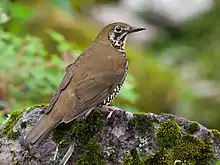Himalayan thrush
The Himalayan thrush or Himalayan forest thrush (Zoothera salimalii) is a species of bird described in 2016 and separated out from the alpine thrush Zoothera mollissima with which they were formerly lumped. The species is separated on the basis of phylogenetic studies that suggest that the population diverged from the common ancestor at least 3 million years ago (estimates vary from 3-6 mya). The alpine thrush (Zoothera mollissima in the restricted sense) breeds above the tree line whereas the Himalayan thrush breeds in forested habitats. The species breeds from Sikkim and Darjeeling in India and extends east into Tibet and further east into northwest Yunnan in China. The species differs in its song from that of the alpine thrush. The Himalayan thrush has a more musical call while that of the Alpine thrush is raspy and grating.[2]
| Himalayan thrush | |
|---|---|
 | |
| Himalayan thrush in Yunnan | |
| Scientific classification | |
| Kingdom: | Animalia |
| Phylum: | Chordata |
| Class: | Aves |
| Order: | Passeriformes |
| Family: | Turdidae |
| Genus: | Zoothera |
| Species: | Z. salimalii |
| Binomial name | |
| Zoothera salimalii Alström et al., 2016 | |
The species name is given in honour of the distinguished Indian ornithologist Sálim Ali.[2]
The tree-dwelling species has shorter legs, tail and wings but a longer bill than its Alpine counterpart, and uses the shorter legs and tails to help it manoeuvre around in the forest.[3]
References
- BirdLife International (2016). "Zoothera salimalii". The IUCN Red List of Threatened Species. IUCN. 2016: e.T103879287A104351365. doi:10.2305/IUCN.UK.2016-3.RLTS.T103879287A104351365.en.
- Alström, Per; Rasmussen, Pamela C.; Zhao, Chao; Xu, Jingzi; Dalvi, Shashank; Cai, Tianlong; Guan, Yuyan; Zhang, Ruiying; Kalyakin, Mikhail V.; Lei, Fumin; Olsson, Urban (2016). "Integrative taxonomy of the Plain-backed Thrush (Zoothera mollissima) complex (Aves, Turdidae) reveals cryptic species, including a new species". Avian Research. 7 (1): 1–39. doi:10.1186/s40657-016-0037-2. ISSN 2053-7166.
- Adam Vaughan (22 January 2016). "New species of bird discovered in India, China by international team of scientists". TheGuardian. Retrieved 22 January 2016.
